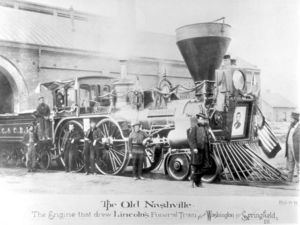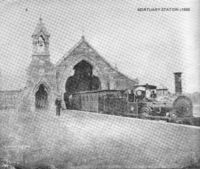Funeral train

A funeral train is a train specially chartered in order to carry a coffin or coffins to a resting place. Funeral trains today are often reserved for leaders and national heroes, as part of a state funeral, but in the past were sometimes the chief means of transporting coffins and mourners to graveyards. Funeral trains remain mostly steam locomotive hauled, due to the more romantic image of the steam train against more modern diesel or electric locomotives.
History
The first funeral train was run by the The London Necropolis and National Mausoleum Company on 7 November 1854. Trains ran once a day from London Necropolis railway station to Brookwood Cemetery. The train carried not only the bodies of the dead, but the parties of mourners who had come to attend the funeral services. Different classes were available for both the living and the dead; a more expensive first class ticket would provide a more ornate coffin and greater care of the body during transit. The London Necropolis Company was run by London and South Western Railway, who feared that regular passengers would shun locomotives which had previously hauled funeral trains, and therefore purchased an entirely new fleet exclusively for the Necropolis line. The public were initially reserved about the project; one bishop expressed fears that "It may sometimes happen that persons of opposite characters might be carried in the same conveyance. For instance, the body of some profligate spendthrift might be placed in a conveyance with the body of some respectable member of the church, which would shock the feelings of his friends".[1] Others felt that the railway industry, which was less than 20 years old and still very much a new technology, was too hectic and loud, ill-befitting the sombre mourning associated with Christian funeral services.
The line ran daily – including Sundays – for almost 50 years until 1900, when the Sunday service was stopped and trains began to run on an "as needed basis". The railway remained in operation through the First World War and Second World War until 16 April 1941, when the London Necropolis station was bombed in the London Blitz. The station was never rebuilt and the line fell into disuse.[2]
Australia
In Sydney, Australia, there was a similar service whereby the Rookwood Cemetery railway line, Sydney served the Rookwood Cemetery complex. From 1867 until 1948 trains would depart Mortuary Station in Sydney City and travel the 15 kms to Rookwood Cemetery.[3]
State funerals
Although most funeral services now make use of road-going hearses rather than trains, funeral trains remain common for the funerals of heads of state; all British monarchs since Queen Victoria have been carried by funeral trains; King Edward VII and King George VI were both taken to the Windsor and Eton Central railway station for the funeral procession. Most British Prime Ministers do not receive funeral trains. However, as part of his state funeral, Winston Churchill's coffin was carried by an SR "Battle of Britain" Class locomotive Winston Churchill to Blenheim Palace.[4] Presidents of the United States are also sometimes transported by train; Abraham Lincoln, Franklin D. Roosevelt, and Dwight D. Eisenhower were all given funeral trains as part of the procession.
Gallery
John A. Macdonald's funeral train.
Winston Churchill's funeral train, 34051 Winston Churchill.
References
- ↑ The Deathline - Fortean Times (Registration required). URL accessed 11 November 2006
- ↑ The Cemetery Railway. URL accessed 11 November
- ↑ CityRail, Welcome to Central Station.
- ↑ The Churchill Project Appeal. URL accessed 11 November 2006



